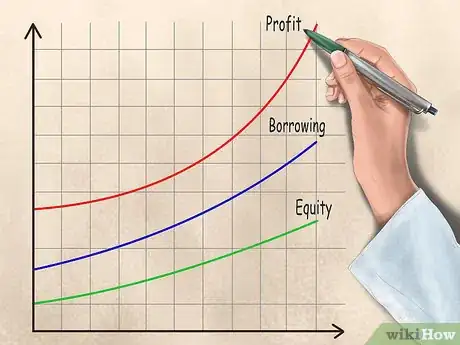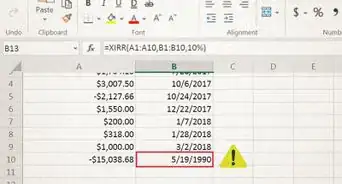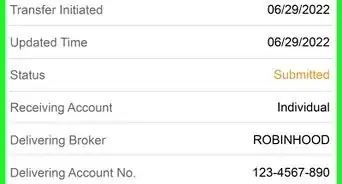This article was co-authored by Darron Kendrick, CPA, MA. Darron Kendrick is an Adjunct Professor of Accounting and Law at the University of North Georgia. He received his Masters degree in tax law from the Thomas Jefferson School of Law in 2012, and his CPA from the Alabama State Board of Public Accountancy in 1984.
There are 15 references cited in this article, which can be found at the bottom of the page.
This article has been viewed 177,442 times.
Calculating free cash flow to equity (FCFE) provides you with a measure of a company's ability to pay dividends to its stockholders, cover additional debt, and make further investments in the business. FCFE represents the cash available to the company’s common stockholders after operating expenses, taxes, debt payments, and expenditures needed to sustain production have been accounted for. [1] A company’s FCFE can provide insight into the strength or weakness of a company, or its ability to generate sustainable earnings — the analysis will depend on which of these two perspectives is your focus. To calculate FCFE, you will need to examine various accounts on the Balance Sheet to get an accurate assessment of cash flow.
Steps
Understanding FCFE
-
1Learn the basics of FCFE calculation inputs. There is a general formula used to determine FCFE, but within that formula, analysts have a lot of discretion in choosing the inputs as they interpret the data depending on the objective (to determine if the company is healthy, or to check how much cash can be paid to the shareholders). Because FCFE represents the available cash after expenses, payments, and “expenditures needed to sustain production” have been accounted for, you need to decide what you will count as these “expenses.” Consider your own life as an example to help you understand.
- For example, if you were to tabulate your personal income over the course of three months, you’d have your quarterly earnings. Now, if we wanted to know your FCFE available at the end of this period, we would begin deducting your expenses from your income.
- Rent and mortgage payments, debt payments, taxes, and the like are expenses that are certain. If you are to continue operating, you will have to continue paying these, so they need to be accounted for. These items definitely need to be deducted.
- Sometimes, however, other items that might seem discretionary are as much a part of your earning capabilities as the others. The tricky part begins when we focus on those “expenditures to sustain production”.
- For example, consider your gym membership. If you’re a dentist, going to the gym is a healthy choice, but it’s probably not vital to your earning potential. However, if you’re a professional bodybuilder, your gym membership is directly tied to your ability to earn money. Failure to maintain this membership would cause you to earn less money. If this is the case, you should account for this expense by deducting it from your salary, leaving less FCFE.
-
2Understand the role of the analyst. It is up to the analyst to determine what expenses and re-investments of capital are needed for a company to maintain and/or drive growth in earnings. Valuing assets is not always entirely straightforward, and the details of how it is calculated may in fact change from asset to asset. Valuation is part data analysis, part creative thinking. [2]
- For example, if a company reduces its purchases of equipment, expenses may decrease in the near-term and boost FCFE but cause growth to erode or disappear over the long run. A good analyst would immediately notice this and be able to act accordingly, probably by selling off their stock in that company.
Advertisement -
3Learn the formula for FCFE. There are a number of different paths you can use to directly or indirectly calculate FCFE, but the most straightforward formula is as follows: FCFE = NI + NCC + Int x (1 - Tax Rate) – FCInv – WCInv + Net Borrowing. [3] The individual terms are defined below.
- NI: Net income. This is the company’s total profit after subtracting from its revenue all of its expenses and taxes for the specified accounting period.
- NCC: Non-cash charges. These are expenses deducted from a company’s revenue that did not require an actual payment of cash in the period. For example, the depreciation expense taken in the current period for the previous cost to build a factory. [4]
- Int: Interest income.’ This is income received by suppliers of debt capital. This would include interest received from money loaned out to others. This item mostly applies to financial firms. [5]
- FCInv: Fixed Capital Expenditures. These are purchases made by a company that are necessary to maintain or increase their operations and productivity, such as the purchase of new ships for a transportation company. [6]
- WCInv: Working Capital Investment. This is found by subtracting a company’s current assets (cash, inventory, and accounts receivable) from its current liabilities (short term debt and accounts payable). This measures a company’s ability to meet its near-term expenses and includes the amount of cash and equivalents available to reinvest and grow its business. [7]
- Net Borrowing. This is calculated by subtracting the amount of principal that a company repays on the debt it currently owes during the period measured from the amount it borrowed during the same period. In other words, Net Borrowing = Amount Borrowed - Amount of Principal Repaid. If a company borrows more cash than it repays, it has more cash to share with the owners of equity.[8]
-
4Understand when it’s appropriate to use FCFE. The FCFE isn't appropriate in every situation; however, it can give you insight into the availability and use of cash if the following apply to the company you’re examining:
- The company is profitable
- The company’s borrowing is stable
- You are focused on valuing the company’s equity
Calculating FCFE
-
1Obtain the company's information. The income statements, cash flow statements, and balance sheets of any publicly traded company should be available from the company itself or from an organization like NASDAQ.[9]
- These documents will provide the most vital information you need for calculating FCFE.
- Any other information you can gather that provides a more detailed look at how the company is spending its money may also be useful in making your analysis.
-
2Find the company's net income for the most recent year. This is typically located on the bottom line of the income statement.
- In our example, we'll keep it simple: $2,000,000 (2 million) is Company ABC's net income.
-
3Add non-cash charges. This includes things like depreciation and amortization. These are usually listed on the income statement, but may also be found on the cash flow statement. These are accounting expenses that reduce earnings but are not cash expenses. [10]
- These expenses should be added because they don't represent actual money spent, and therefore these funds are theoretically available as equity for stockholders.
- In our example, we'll say that Company ABC had $200,000 in non-cash charges for this year.
- $2,000,000 + $200,000 = $2,200,000
-
4Subtract fixed capital expenditures. You must subtract expenditures that are necessary for the company to continue or increase its productivity, such as new equipment.
- You can estimate this by using the "capital expenditures" figure on the company's cash flow statement. [11]
- Let's say for our example that Company ABC had $400,000 in fixed capital expenditures.
- $2,200,000 - $400,000 = $1,800,000.
-
5Subtract working capital investments. Every company must expend some of its funds on day-to-day operations. These are its working capital investments. [12] You can estimate this using a company's current assets and current liabilities, obtained from a recent balance sheet.
- Subtract a company's current assets from its current liabilities. [13] This tells you how much money a company has for day-to-day business expenses, planned or unplanned.
- This figure can be a measure of a company's short-term financial health. [14] A company with no positive working capital is unlikely to stay afloat for long. [15]
- By contrast, too much working capital can be seen as a sign of inefficiency, as it can indicate the company is not investing its excess assets in a way that could result in greater profit. [16]
- In our example, let's say Company ABC had $200,000 in working capital investments.
- $1,800,000 - $200,000 = $1,600,000.
-
6Add net borrowing. Add additional funds the company may have on hand as result of borrowing. This is determined by subtracting the amount paid on debts from the amount borrowed over the period you are considering.
- To make this calculation, compare debt figures on a company's balance sheet. [17] Subtract the amount of debt at the beginning of the period from the amount at the end. A positive number means net borrowing has increased, while a negative figure means a decrease in net borrowing.
- Let's say Company ABC borrowed $500,000 this year.
- $1,600,000 + $500,000 = $2,100,000
- Therefore, the company's FCFE is $2.1 million.
-
7Consider your results. The purpose of these calculations are to remove items that do not reflect reality.The outcome will allow you to determine how much cash is actually coming in and how much is going out. This in turn tells you how much could potentially be paid out to the company's investors.[18]
- A skilled analyst can use this information to discover mispricing (i.e., to determine whether a company is being over- or under-valued by others) and adjust their valuation accordingly.
- Look for sustained discrepancies between FCFE and the rate of dividends being paid. This suggests the presence of additional cash in the hands of the company that the analyst should take note of, and can be a positive sign, as it means the business has cash available for investment, share repurchases, a dividend increase, or perhaps to protect against a potential downturn.
- On the other hand, if the dividend exceeds FCFE, there could be an issue with the dividend being sustainable.
Expert Q&A
Did you know you can get expert answers for this article?
Unlock expert answers by supporting wikiHow
-
QuestionChip’s Home Brew Whiskey management forecasts that if the firm sells each bottle of Snake-Bite for $20, then the demand for the product will be 15,000 bottles per year, whereas sales will be 90 percent as high if the price is raised 10 percent. Chip’s variable cost per bottle is $10, and the total fixed cash cost for the year is $100,000. Depreciation and amortization charges are $20,000, and the firm has a 30 percent marginal tax rate. Management anticipates an increased working capital need of $3,000 for the year. What will be the effect of the price increase on the firm’s FCF for the year?
 Michael R. LewisMichael R. Lewis is a retired corporate executive, entrepreneur, and investment advisor in Texas. He has over 40 years of experience in business and finance, including as a Vice President for Blue Cross Blue Shield of Texas. He has a BBA in Industrial Management from the University of Texas at Austin.
Michael R. LewisMichael R. Lewis is a retired corporate executive, entrepreneur, and investment advisor in Texas. He has over 40 years of experience in business and finance, including as a Vice President for Blue Cross Blue Shield of Texas. He has a BBA in Industrial Management from the University of Texas at Austin.
Business Advisor
-
QuestionHow does FCFE help me with my business?
 Michael R. LewisMichael R. Lewis is a retired corporate executive, entrepreneur, and investment advisor in Texas. He has over 40 years of experience in business and finance, including as a Vice President for Blue Cross Blue Shield of Texas. He has a BBA in Industrial Management from the University of Texas at Austin.
Michael R. LewisMichael R. Lewis is a retired corporate executive, entrepreneur, and investment advisor in Texas. He has over 40 years of experience in business and finance, including as a Vice President for Blue Cross Blue Shield of Texas. He has a BBA in Industrial Management from the University of Texas at Austin.
Business Advisor
References
- ↑ pages.stern.nyu.edu/~adamodar/New_Home_Page/AppldCF/derivn/ch11deriv.html
- ↑ http://pages.stern.nyu.edu/~adamodar/New_Home_Page/background/valintro.htm
- ↑ http://www.investopedia.com/exam-guide/cfa-level-1/financial-statements/free-cash-flow.asp
- ↑ http://www.investopedia.com/terms/n/noncashcharge.asp
- ↑ http://pages.stern.nyu.edu/~adamodar/New_Home_Page/AppldCF/derivn/ch11deriv.html
- ↑ http://www.investopedia.com/terms/f/fixed-capital.asp
- ↑ https://www.sba.gov/content/working-capital
- ↑ http://www.ftsmodules.com/public/texts/valuationtutor/VTchp7/topic9/topic9.htm
- ↑ http://www.nasdaq.com/quotes/company-financials.aspx
- ↑ http://www.nasdaq.com/symbol/znga/financials?query=cash-flow
- ↑ pages.stern.nyu.edu/~adamodar/New_Home_Page/AppldCF/derivn/ch11deriv.html
- ↑ http://www.capital-investment.co.uk/working-capital-investment.php
- ↑ http://www.capital investment.co.uk/working-capital-investment.php
- ↑ http://www.investopedia.com/terms/w/workingcapital.asp
- ↑ https://www.sba.gov/content/working-capital
- ↑ http://www.investopedia.com/terms/w/workingcapital.asp
- ↑ http://www.financeformulas.net/Free-Cash-Flow-to-Equity.html
- ↑ http://people.stern.nyu.edu/adamodar/pdfiles/papers/valuesurvey.pdf
About This Article
To calculate a company’s free cash flow equity, start by finding the company’s net income for the most recent year, which is most likely listed on the bottom of its income statement. Then, add non-cash charges, such as depreciating assets, and subtract fixed capital expenditures like new equipment, for example. Next, subtract working capital investments, which can be calculated by subtracting the company’s current assets from its liabilities. Finally, add the company’s net borrowing, which is the difference between the debt at the end of a period and the beginning. For more help from our Financial co-author, like how to include interest income, read on!







































































